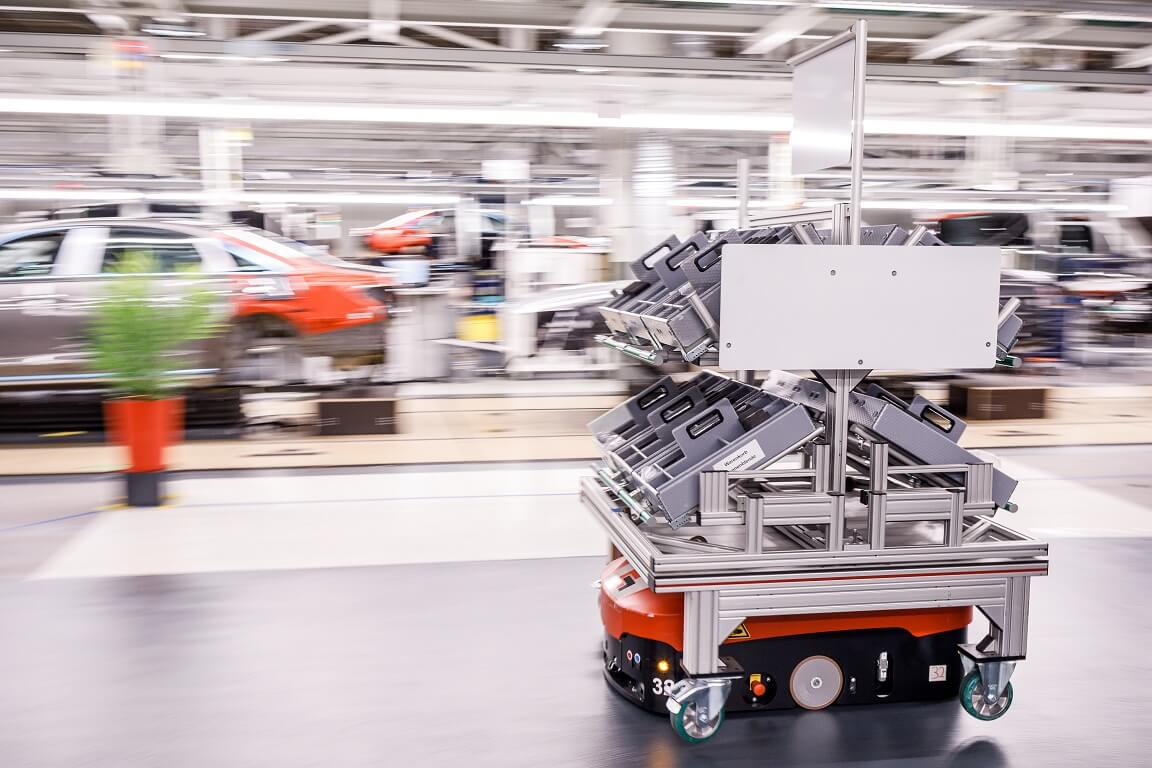When talking about a supermarket, you would assume, we are talking about ‘Albert Heijn’ or another store, selling groceries. Not so, when discussing the supermarket, installed in production hall A11 at the Audi production plant in Neckarsulm. Here, all parts for the assembly of the A8 are stored and, in accordance with the production plan, prepared for pick up. Logistic employees collect the necessary parts from the supermarket and place these in boxes, stored on special wagons, ready to be delivered to the production line.
This is, when it gets interesting: Automated Guided Vehicles (AGV) transport these wagons to their destination within the production line.
Audi argues, that due to the higher complexity of the new A8, these AGVs relieve the workload of their logistic employees, instead of taking over their jobs. The 30 AGVs in the A8 production hall travel an average of 170km per shift, at a maximum speed of 3.6km/h, for safety reasons.
The AGVs are connected via WIFI with the so-called fleet-manager, together forming the Driverless Transport System (DTS). The vehicles, equipped with GPS and an integrated map of the production plant, as well as two laser scanners to orientate within the facilities, use intelligent navigation software to deliver the parts precisely on time to the recipient. Similar like a taxi service, the AGV, closest to the next job, is ordered for delivery. The DTS is connected to an elevator, so that the vehicles can move independently through the different levels of the production plant.
Due to its machine learning capabilities, the DTS is able to figure out optimal routes for each job, and knows, when to send the AGVs back to its charging mat in order to recharge. The AGVs recognize size and weight of the loaded wagon and adapt the specific safety field (if an obstacle is detected within this field, the AGV stops immediately). This enables, that humans and AGVs can both make use of the same paths, without risking collisions.
Seeing this technology successfully working directly together with humans opens questions about future applications in our day-to-day life: Could we imagine having robots delivering us food and medication in hospitals, instead of nurses? Would we mind accepting a parcel from a DTS, rather than from the post employee? Or are we not willing to sacrifice these moments of social contact, in order to experience potentially higher efficiency?
Sources:
Ludwig, C. (2018). Audi’s logistics part 1: Prepared for a new reality. Retrieved 06 September 2018, from https://automotivelogistics.media/intelligence/130890
Först, L. (2018). That’s how a supervisor for driverless transport systems works. Retrieved 06 September 2018, from https://blog.audi.de/thats-how-a-supervisor-for-driverless-transport-systems-works/?lang=en
Först, L. (2018). Driverless transport vehicles in use for the Audi A8. Retrieved 06 September 2018, from https://blog.audi.de/driverless-transport-vehicles-in-use-for-the-audi-a8/?lang=en

